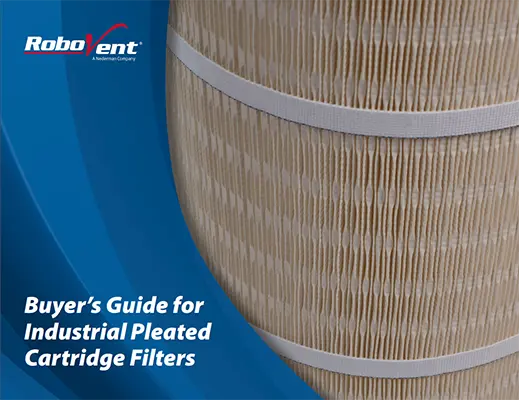Welding Fume Filters: Everything You Need to Know
Welding fumes present multiple health risks, from metal fume fever to neurological problems, lung disease and cancer. Fortunately, weld fume extraction systems with appropriate weld fume filters can remove the majority of harmful components in welding smoke. Whether it’s a source capture or ambient air filtration system, choosing the right welding fume filter is crucial for effectively capturing the small, often sub-micron, particulate present in welding fumes. There are a variety of factors that influence filter selection for weld fumes, including the welding application, the operating environment and more.
Want to know more? Download the Buyer’s Guide for Industrial Pleated Cartridge Filters.
Filtration Basics for Welders
The Occupational Safety and Health Administration (OSHA) has set Permissible Exposure Limits (PELs) for total weld fume exposure as well as for individual components found in some welding fumes, such as hexavalent chromium and manganese. To meet weld fume PELs and ensure welder safety, fume collection systems utilizing welding fume filters are implemented. A dust collection system for weld fumes consists of:
- a stationary or portable dust collector with filters
- a capture hood/system that is ducted to the dust collector, such as an enclosure hood (for robotic welding) or a fume arm, fume gun or backdraft plenum (for manual welding).
The dust collector pulls the weld fume into a filter chamber (or, in the case of baghouse dust collectors, into a filter bag), where contaminants found in weld smoke are captured in the filter media. Clean, filtered air can then be returned to the facility or vented to the outdoors. Cartridge dust collectors are used widely across many industries where welding is prevalent, as they offer an efficient means of capturing dangerous fumes associated with welding. These dust collectors use cylindrical, pleated filter cartridges. This pleated design provides a more expansive filtration surface area in a more compact space compared to bag filters.
What are cartridge air filters?
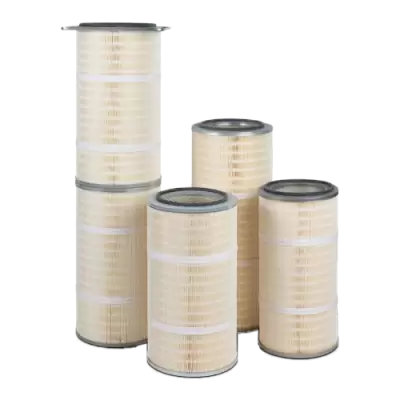
Understanding Filtration Efficiency
Filtration efficiency refers to the ability of a filter to capture particles of various sizes as air passes through the filter media.
- The majority of filters built for capturing weld fumes are rated using the Minimum Efficiency Reporting Value (MERV) system, which ranges in efficiency from 1 through 16, with 16 being the most efficient. The MERV rating is based on the percentage of particulates collected in three different size bands: 3-10 microns, 1-3 microns, or 0.3-1 microns. A MERV 15 collects at least 85% of particles in the 0.3-1 micron range, while a MERV 16 filter collects 95% of such particles.
- High-Efficiency Particulate Air (HEPA) filters surpass the filtration efficiency of a MERV-16 filter, capturing 99.97 percent of particles 0.3 microns or larger.
Read more: Understanding Filtration Efficiency
Filter Media Types
Filters are made with different types of media for different environments and industrial uses. Common filter types include:
- Cellulose: A versatile media for light duty and general use in collection of dry particulate.
- Cellulose/polyester blend: Built for high humidity environments and captures moist dust and heavier dust loads.
- Spunbound polyester: The nonwoven fiber/continuous filament polyester fibers make this filter resistant to chemicals. It also holds up to high temperatures and challenging industrial environments.
- Nanofiber: These filters have a layer of nanofiber (very fine fibers) over another substrate, often polyester or blended. The nanofiber layer makes these filters better at capturing submicron particles, such as those in weld fume.
- Polytetrafluorethylene-coated (PTFE): These filters have a thin PTFE membrane on top of the substrate that offers high filtration efficiency and excellent moisture, chemical and abrasion resistance. Commonly used in situations where the particulate will be moist, oily, sticky or abrasive.
- Oleophobic media: This filter media is built to repel oil and other hydrophobic substances.
Read more: Industrial Cartridge Filters – Major Types and Configurations.
Selecting the Right Filter for Weld Fumes
The starting point for most organizations as they select the right filter for weld fumes is knowing the PELs associated with the particulate generated in their specific type(s) of welding. Each welding process can produce distinct toxic particles and at different concentrations, and having knowledge of this fume load can inform decisions on weld fume filters. Read more: Weld Fume Basics.
Another factor is other types of industrial processes that introduce different particulate into the air. Welding fumes generate dry particles, so if wet/oily/sticky substances generated outside of the welding applications are also being filtered in the dust collection system, this needs to be entered into the equation when selecting filters.
Welding Fume Characteristics and Filtration Efficiency
One of the biggest challenges in capturing welding fumes is that the particles involved are very small, with most particulate in the submicron range. When metal is vaporized during the intense thermal process of welding, fumed particulate becomes airborne. These hazardous substances can be inhaled easily and deeply into the lungs and present a serious health risk. Read more: Health risks of weld fumes.
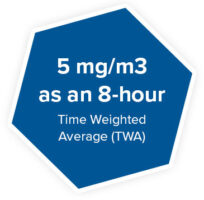 OSHA has set exposure limits (PELs) based on a time-weighted average of exposure through an eight-hour shift. The PEL is 5 mg/m3 when welding mild steel, iron or aluminum. However, OSHA has also set PELs for individual compounds and elements found in welding fumes.
OSHA has set exposure limits (PELs) based on a time-weighted average of exposure through an eight-hour shift. The PEL is 5 mg/m3 when welding mild steel, iron or aluminum. However, OSHA has also set PELs for individual compounds and elements found in welding fumes.
- Among the most toxic substances in welding fumes is hexavalent chromium, which is highly toxic and a carcinogen found in stainless steel and other high-chromium alloy welding. (PEL: 5 micrograms per cubic meter.)
- Cadmium, which is found in filler materials and solders, can lead to lung cancer. (PEL: 5 micrograms per cubic meter.)
- Beryllium, even in small amounts, can cause lung cancer. (PEL: 0.2 micrograms per cubic meter.)
- Lead, manganese, nickel, aluminum and arsenic are also commonly found in welding fumes and cause a range of problems, from metal fume fever to respiratory problems to severe neurological damage to cancer. (Varying PELs.)
Given the submicron particle sizes in welding fumes, a filter with a higher MERV rating (MERV 15 or 16) is usually required to stay within PELs, especially with more toxic substances like hexavalent chromium, cadmium and beryllium. All cartridge filters will approach a MERV 16 efficiency level as they become loaded and build up a dust cake. However, when working with highly toxic fumes, it is important to start with a filter with an initial efficiency rating high enough to protect welders while new. HEPA filters are not usually required for general welding but may be recommended when working with highly toxic substances with low PELs.
Welding Volume
Welding volume doesn’t necessarily influence the decision about which type of filter to use, but it can inform system design, in particular, the amount of area of filter media required within the dust collection system. The air-to-cloth ratio, or filter velocity, is the ratio between airflow and the area of filter media (e.g., number of filter cartridges) in the system. Dust collector sizing for welding applications must take into account the volume of weld fumes produced by welding processes. The more fume that is generated, the more filter media will be required.
Production Environment
When selecting a filter for mitigating welding fumes, it’s important to consider other factors, such as manufacturing applications occurring in the area that could contribute particulate to the dust collection system. Lubricants and metalworking fluids are commonly found in metalworking and fabrication shops, especially those engaged in cutting and grinding in addition to welding. These processes produce oily particulate that can create issues for dust collection if the filter isn’t made with the right type of media.
Oily particulate can clog some filter media types, causing airflow issues, excess pressure drop, and potential fire hazards. An oleophobic filter media or PTFE-coated filter should be used when collecting oily particulates. Note that these filters are not designed for collection of heavy oil mists and droplets; a specialized oil mist collection system will be needed for heavy oil mists.
Are HEPA Filters Needed for Welding?
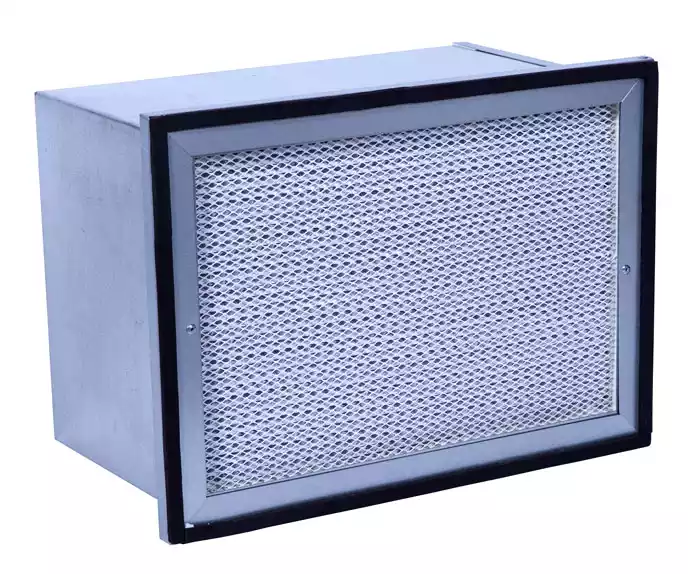 HEPA filters are not always recommended for managing welding fumes, as the MERV 16-rated filter, which is nearly as efficient as the HEPA filter, will suffice for most applications. However, when highly toxic fumes with low PELs are present, HEPA filters may be recommended. Some cartridge dust collectors can be fitted with a HEPA after-filter to collect submicron particles that make it through the primary cartridge filters.
HEPA filters are not always recommended for managing welding fumes, as the MERV 16-rated filter, which is nearly as efficient as the HEPA filter, will suffice for most applications. However, when highly toxic fumes with low PELs are present, HEPA filters may be recommended. Some cartridge dust collectors can be fitted with a HEPA after-filter to collect submicron particles that make it through the primary cartridge filters.
Are Activated Carbon Filters Needed for Welding?
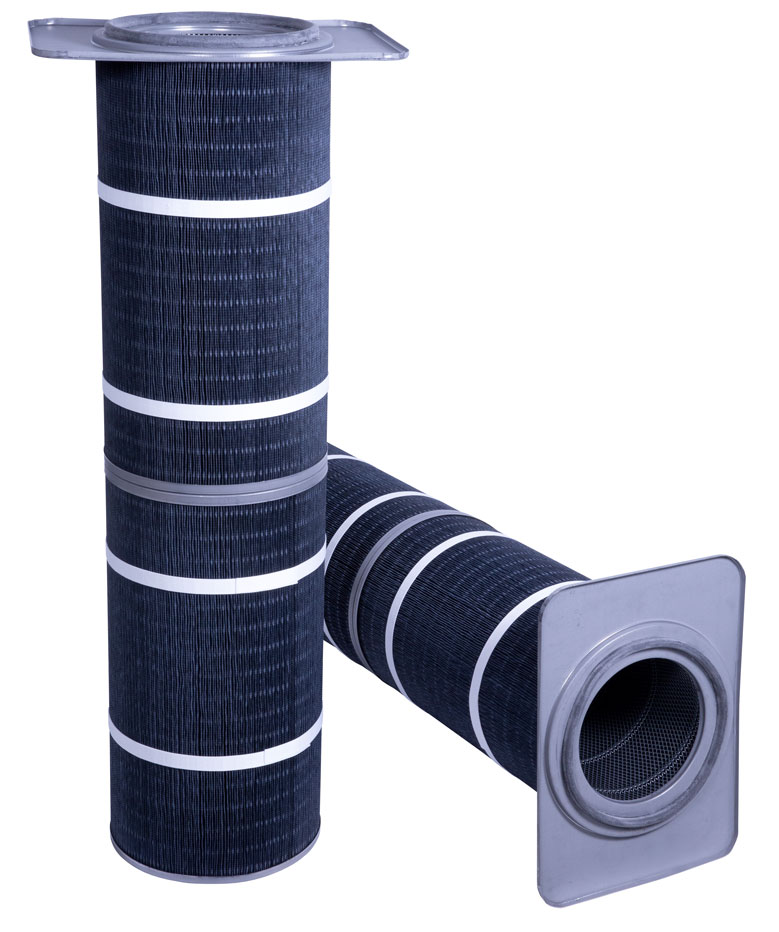 Activated carbon filters are not generally required for managing particulate associated with welding applications. The primary concern with weld fumes is the toxic dry particulate, which is effectively captured with standard dry particulate cartridge filters. Activated carbon filters are used for removing gases, odors and vapors, not dry particulate.
Activated carbon filters are not generally required for managing particulate associated with welding applications. The primary concern with weld fumes is the toxic dry particulate, which is effectively captured with standard dry particulate cartridge filters. Activated carbon filters are used for removing gases, odors and vapors, not dry particulate.
While it is true that welding shield gases can pose a health risk, in properly ventilated environments, shield gases will not accumulate to levels that necessitate activated carbon filters. This does not mean that activated carbon filters will never be recommended in industrial environments where welding takes place, as volatile organic compounds (VOCs), odors and toxic gas-phase emissions can occur through other processes. The highly porous activated carbon filters absorb/trap these contaminants and reduce the health risks associated with them. Activated carbon after-filters can be installed on some types of cartridge dust collectors to collect gas phase emissions.
Are Flame-Retardant Filters Required for Welding?
While there is no specific requirement in regard to using flame-retardant filters in dust collection systems, taking that precaution is recommended for welding applications where sparks could enter the air inlet. These chemically treated filters are designed to withstand high temperatures without igniting or melting. The flame-retardant properties also ensure that sparks do not penetrate the filter and damage it.
Another option to prevent sparks from becoming the source of a fire in the filter or in the ductwork is to implement a spark arrestor, which is a device that catches and “kills” sparks before they hit the filter.
Maintenance of Weld Fume Filters
Weld fume filters require regular maintenance and replacement. Over time, as industrial air passes through the filter, dust and other contaminants begin to build up in a process called filter loading. As filters become loaded, the dust collection system must work harder and use more energy to push air through the system. Filters may also experience wear and tear, resulting in leaks past the filters that can put facilities at risk of non-compliance. Here are some indications that weld fume filters need to be changed:
- Increased pressure drop across the filters.
- Airflow issues.
- Visible tears or pinhole leaks in the filter media or wear around the end cap or gasket.
- Visible dust escaping past the filter chamber.
Pressure drop is often used as an indicator that weld smoke filters are ready to be changed. Your dust collector owner’s manual should provide a filter change threshold for the pressure differential across the filters. This is usually given in inches of water column (WC) or kilopascals (KPA). It is important to change filters when this threshold is reached to ensure proper performance of the dust collection system.
Learn more: Extending the Life of your Dust Collector Cartridge Filters
Order Weld Fume Filters
Your facility has very specific needs, and RoboVent has filters that can meet those needs. We’re the weld fume filtration experts! We manufacture our weld fume filters in-house, which means we can produce filters for virtually any make or model of weld fume extractor.
Don’t risk letting toxic weld fumes into your air supply – let our experts analyze your welding processes and provide you with a welding filter recommendation that will keep your employees safe. Contact us for more information today.
Contact Us With Your Questions!
SUBSCRIBE TO
BLOG UPDATES


